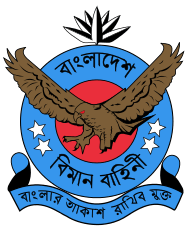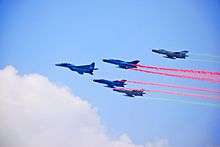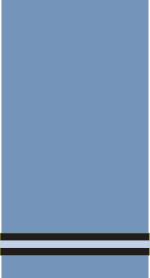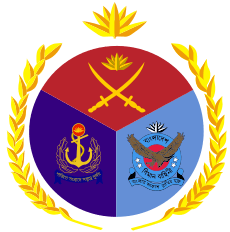Bangladesh Air Force
| Bangladesh Air Force বাংলাদেশ বিমান বাহিনী | |
|---|---|
 The Crest of the Bangladesh Air Force | |
| Active | 1971–present |
| Country | Bangladesh |
| Allegiance | People's Republic of Bangladesh |
| Type | Air force |
| Role | Aerial warfare |
| Size |
14,000 active personnel[1] 4,000 reservists 157 aircraft[2] |
| Part of | Bangladesh Armed Forces |
| Air Headquarters | Dhaka Cantonment |
| Nickname(s) | BAF |
| Patron | The President of Bangladesh |
| Motto(s) |
বাংলার আকাশ রাখিব মুক্ত Transliteration:Banglar Aakash Rakhibo Mukto (Free shall we keep the sky of Bangladesh)[3] |
| Colors | Light Sky, Deep sky |
| Mascot(s) | Flying Eagle |
| Anniversaries | 28 September (Air Force Day), Armed Forces Day (21 November) |
| Engagements |
Bangladesh Liberation War Gulf War Chittagong Hill Tracts operation United Nations peacekeeping missions |
| Website | www.baf.mil.bd |
| Commanders | |
| Commander-in-chief | President Abdul Hamid |
| Chief of Air Staff | Air Chief Marshal Masihuzzaman Serniabat, BBP, OSP, ndu, psc |
| Insignia | |
| Ensign |
 |
| Roundel |
 |
| Aircraft flown | |
| Attack | Yak-130, Mil Mi-17 |
| Fighter | MiG-29, F-7 |
| Helicopter | Bell 206, Bell 212, Mi-17, AW 139, AW 119 |
| Trainer | PT-6, AW 119, Bell 206, L-39, FT-7, K-8, YAK 130, L-410 |
| Transport | C-130, An-32 |
The Bangladesh Air Force (Bengali: বাংলাদেশ বিমান বাহিনী, Bangladesh Biman Bahini, reporting name: BAF), is the aerial warfare branch of the Bangladesh Armed Forces, primarily tasked with the air defence of Bangladesh territory and providing air support to the Bangladesh Army and Navy. Additionally, the service has a territorial role of providing strategic air transport and logistics capability for the country.
Since its establishment on 28 September 1971, the Air Force has been involved in various combat and humanitarian operations, from the Bangladesh Liberation War in which it was born, to supporting international efforts including the Coalition of the Gulf War and United Nations peacekeeping missions.
History
Foundation

The Bangladesh Air Force was officially formed at the Sector Commanders Conference during Bangladesh's independence war from Pakistan in 1971. Its official date of formation has been established as 28 September 1971 and it was launched formally by the government on 8 October 1971.[4] BAF's initial personnel were Bengali members of the Pakistan Air Force who were stationed in East Pakistan at the outbreak of the war and who deserted to the Bangladeshi side.[4] At that time, the embryo of Bangladesh Air Force BAF was formed with less than a hundred officers and a quite good number of airmen and warrant officers. A significant number of BAF personnel participated in the Bangladesh War of Independence. During the independence war, officers of the BAF attached to the Z-Force were then Bangladesh Gov't Representative to Chakulia Guerrilla Training Camp Squadron Leader M. Hamidullah Khan,[5] later Sub-Sector Commander and as Commander-Sector 11, Flight Lieutenant Liaqat as Battalion Adjutant, Flying Officer Rouf, Flying Officer Ashraf and Flight Sergeant Shafiqullah as company commanders. Squadron Leader Sadruddin Hossain, Squadron Leader Wahidur Rahim, Squadron Leader Nurul Qader, Squadron Leader Shamsur Rahman and Air Commodore Ataur Rahman as sub sector company commanders. Squadron Leader Khademul Bashar participated in the war as Commander-Sector 6.[6]
Bangladesh Air Force was organised in India with the initiative of Squadron Leader Sultan Mahmud (Ex-PAF Pilot), Captain Shahabuddin Ahmed (Ex-PIA Pilot), Captain Akram Ahmed (Ex-Plant protection Pilot) and Captain Sattar (ex-PIA Pilot) and Captain Sarfuddin (Ex-PIA Pilot). Later many Bangladeshi ex-PAF Officers joined in Bangladesh Air Force in India. Finally, Bangladesh Air Force was formed in late July 1971. Indian Air Force trained these Officers July 1971 through November 1971 as fighter pilots. Bangladesh Air Force first went in action on 3 December 1971 and attacked the Chattogram-based Oil tank depot and oil tank depot was totally destroyed by that air attack. The Air attack was conducted by Capt. Akram Ahmed.[7] The second Bangladesh Air Force attack was on 6 December 1971 at Moulovi Bazar Pakistani Army barracks under the command of Squadron Leader Sultan Mahmud, where Captain Shahabuddin Ahmed was co-pilot.[7]
.jpg)
Indian civilian authorities and the IAF donated 1 DC-3 Dakota (gifted by the Maharaja of Jodhpor), 1 Twin Otter plane, and 1 Alouette III helicopter for the newborn Bangladesh Air Force,[8] which was to take advantage of the lack of night-fighting capability of the PAF to launch hit-and-run attacks on sensitive targets inside Bangladesh from the air.[9] The Bengali rank and file fixed up the World War II vintage runway at Dimapur, then began rigging the aircraft for combat duty. The Dakota was modified to carry 500 pound bombs, but for technical reasons it was only used to ferry Bangladesh government personnel. Captain Abdul Khalek, Captain Alamgir Satter, and Captain Abdul Mukit, all destined to earn the Bir Pratik gallantry award, piloted the DC-3 Dakota. The Alouette III helicopter was rigged to fire 14 rockets from pylons attached to its side and had .303 Browning machine guns installed, in addition to having 1-inch (25 mm) steel plate welded to its floor for extra protection. Squadron Leader Sultan Mahmood, Flight Lieutenant Bodiul Alam, and Captain Shahabuddin, all of whom later won the Bir Uttam gallantry award, operated the helicopter. The Twin Otter boasted 7 rockets under each of its wings and could deliver ten 25 pound bombs, which were rolled out of the aircraft by hand through a makeshift door. Flight Lt. Shamsul Alam, along with Captains Akram Ahmed and Sharfuddin Ahmad, flew the Otter - all three were later awarded Bir Uttam for their service in 1971. This tiny force was dubbed Kilo Flight, the first fighting formation of the nascent Bangladesh Air force. Squadron Leader Sultan Mahmud was appointed as the commander of the 'Kilo Flight'.[10][11]
After independence
After independence, the BAF received a significant donation from the former USSR. Among the aircraft delivered were ten single-seat Mikoyan-Gurevich MiG-21MFs and two twin-seat Mikoyan-Gurevich MiG-21UMs. Later China also supplied some equipment.[8]
Apart from the aircraft of Kilo Flight which were donated to India, most Pakistan Air Force aircraft grounded in Dhaka due to runway cratering by the Indian Air Force during the liberation war, were sabotaged before surrender. Many of these were also returned to service by Bangladeshi ground technicians. The Pakistan Air Force prior to 1971 had many Bengali pilots, air traffic controllers, technicians and administrative officers. Many of them distinguished themselves during the Bangladesh Liberation War, they provided the nascent Bangladesh Air Force with a good number of trained personnel. It had grown with the repatriation of Air Force personal from Pakistan in 1973 after the Simla Agreement.[4] In 1977 some personnel of Bangladesh Air Force staged a mutiny.[12]

Defence co-operation improved with Pakistan considerably under the military regimes of Ziaur Rahman and Hossain Mohammad Ershad in Bangladesh, which had grown more distant from its war ally, India. Common concerns over India's regional power have influenced strategic co-operation leading to a gift of several squadrons of refurbished Shenyang F-6 fighter aircraft from Pakistan to the Bangladesh Air Force in the late 1980s.[8] Bangladesh bought 8 Mig-29 from Russia in 1999 under Prime Minister Sheikh Hasina.[13] Bangladesh Air Force Academy (BAFA) received National colours in 2003 by the then Prime Minister Khaleda Zia. The Recruits’ Training School (RTS) has been awarded with BAF Colours by ex-Chief of Air Staff (AVM Fakhrul Azam) in 2004. In 2017 Bangladesh Air Force was awarded the Independence Day Award.[14]
Forces Goal 2030
.jpg)
The Bangladesh Air Force has an ambitious modernisation plan to be implemented in upcoming years under Forces Goal 2030. As per the goal, air force is to be a strong deterrent force to well protect the sky of Bangladesh. Plans are made to strengthen both air power and land based air defence capabilities. Since the formulation of the forces goal 2030, the BAF has developed in many folds.
Since 2010, BAF has taken the delivery of sixteen Chengdu F-7BGI fighter aircraft, sixteen Yakovlev Yak-130 advanced jet trainers, nine K-8W jet trainer aircraft, three Let L-410 Turbolet transport trainer aircraft[15] and twenty three PT-6 basic trainers.[16] Process is going on for the procurement of eight multirole combat aircraft.[17][18]
BAF has also taken the delivery of sixteen Mi-171Sh combat transport helicopters, two AgustaWestland AW139 maritime SAR helicopters[19] and two AW 119KX training helicopters since 2010.
BAF earned the Surface to Air Missile capability by introducing FM-90 short range air defence missile in 2011.[20] Till date, BAF Has taken the delivery of two regiments of FM-90 systems. Bangladesh air force will receive Italian origin long range Selex RAT-31DL air defence radar and a short range air defence radar soon. Process of procuring one battery of medium range surface to air missile system is going on.[21]
UN mission deployment
More than 600+ BAF personnel, including officers and airmen, 10 BAF helicopters and are currently deployed to various UN Missions. Another C-130 transport aircraft is providing support to UN Mission in Africa. With the deployment of C-130 aircraft and its personnel, Bangladesh became the largest troops contributing country in UN peacekeeping missions.
List of the Chiefs of Air Staff
Main Article : Chief of Air Staff of the Bangladesh Air Force
Organisation
According to the Constitution of Bangladesh, President of Bangladesh act as the civilian commander-in-chief, and Chief of Air Staff (COAS), by statute a four-star air officer (air chief marshal), commands the Air Force.[22] The Bangladesh Air Force is currently commanded by Air Marshal Masihuzzaman Serniabat,BBP, OSP, ndu, psc.[22][23]
The Bangladesh Air Force (BAF) has its headquarters at Dhaka Cantonment. HQ has 3 branches, Operations & Training (Ops. & Trng.), Administration and Special Duties (Admin. & SD) and Material & Maintenance (M & Mte). Each branch is headed by officers who are considered as principal staff officer (PSO) and known as assistant chief of air staff, e.g. ACAS (Ops & Trng). Under each PSO there are various directorates headed by directors of group captain/air commodore rank. Under each director there are deputy directors (DD) headed by wing commanders and staff officers (SO) with rank of squadron leader and below.
|
|
|
|
Senior commanders
| Shoulder | Appointment | Rank & Name | Star Plate |
|---|---|---|---|
| Chief of Air Staff | Air Chief Marshal Masihuzzaman Serniabat, BBP, OSP, ndu, psc, GD(P)[22] | ||
| Assistant Chief of the Air Staff (Operations) | Air Vice Marshal M Sanaul Huq, OSP, GUP, ndc, psc, GD(P) | ||
| Assistant Chief of Air Staff (Administration) | Air Vice Marshal M Abul Bashar, OSP, ndc, psc, GD(P) | ||
| Assistant Chief of Air Staff (Planning) | Air Vice Marshal Ehasanul Gani Choudhury, OSP, GUP, ndu, psc | ||
| Assistant Chief of Air Staff (Maintenance) | Air Vice Marshal M Quamrul Ehsan, BUP, ndc, psc | ||
| Air Officer Commanding, BAF Base Khademul Bashar (Dhaka) | Air Vice Marshal Md Shafiqul Alam, BSP, ndc, afwc, psc | ||
| Air Officer Commanding, BAF Base Bangabandhu (Dhaka) | Air Vice Marshal M Sayed Hossain, BSP, GUP, ndc, psc, GD(P) | ||
| Air Officer Commanding, BAF Base Zahurul Haq (Chattogram) | Air Vice Marshal Muhammad Mafidur Rahman, BUP, ndu, afwc, psc, GD(P) | ||
| Air Officer Commanding, BAF Base Matiur Rahman (Jashore) | Air Vice Marshal AHM Fazlul haque, BSP, ndu, afwc, psc, GD(P) | ||
| Air Officer Commanding, BAF Base Paharkanchanpur (Tangail) | Air Commodore M Habib Ahsan Khan, BSP, ndu, psc, GD(P) | ||
| Air Officer Commanding, BAF Base Cox's Bazar | Air Commodore Hasan Mahmood Khan, GUP, nswc, psc, GD(P) |
Trades (Airmen)[24]
Trades of Bangladesh Air Force are:
- Aircraft Engineering
- Electrical and Instrument Engineering
- Communications and Electronics
- General Engineering
- Mechanical Transport Fitting
- Mechanical Transport Operating
- Armament Engineering
- Radio Engineering
- Ground Signalling
- Radar Operating
- Life Saving Equipment
- Photography
- Air Traffic Control
- Education
- Cypher
- Meteorological
- Medical
- Secretarial
- Supply
- General Service
- Provost
- Catering
- Musician
- Aircrew
- Ground Combat
Branches (officer)
Branches of Bangladesh Air Force are:
- General Duties (Pilot), abbreviation: GD(P)
- General Duties (Navigator), abbreviation: GD(N)
- Air Defense Weapons Controlling
- Air Traffic Controlling
- Meteorology
- Engineering
- Logistics
- Administration
- Finance/Accounts
- Education
- Legal
- Medical (officers are seconded from army)
Rank structure
| Ranks Bangladesh Air Force | |||||||||||||
|---|---|---|---|---|---|---|---|---|---|---|---|---|---|
| NATO code | OF-10 | OF-9 | OF-8 | OF-7 | OF-6 | OF-5 | OF-4 | OF-3 | OF-2 | ||||
 |
 |
 |
 |
 |
 |
 |
 |
 |
No equivalent | No equivalent | |||
| Air Chief Marshal | Air Marshal | Air Vice-Marshal | Air Commodore | Group Captain | Wing Commander | Squadron Leader | Flight Lieutenant | Flying Officer | |||||
| NATO code | OR-9 | OR-8 | OR-7 | OR-6 | OR-5 | OR-4 | OR-3 | OR-2 | OR-1 | ||||
.jpg) |
.jpg) |
.jpg) |
 |
 |
No equivalent | No equivalent | No equivalent | No equivalent | |||||
| Master Warrant Officer | Senior Warrant Officer | Warrant Officer | Sergeant | Corporal | Leading Aircraftman | Aircraftman 1 | – | – | – | – | |||
InstallationsBAF Headquarters is located in Dhaka Cantonment. There are numerous bases set up all over the country. BAF Base Khademul Bashar Dhaka, BAF Base Bangabandhu Dhaka, BAF Base Zahurul Haque Chattogram and BAF Base Matiur Rahman Jashore are named after National as well as Air Force heroes. Other major bases are BAF Base Pahar Kanchanpur Tangail and Forward Operations Base at Cox's Bazar. There are also several independent units and detachments in places like Moulavibazar Radar Unit (MRU), Bogura Radar Unit (BRU), Lalmonirhat Unit, No. 74 Squadron Bangladesh Air Force at Chattogram and No.71 Squadron Bangladesh Air Force at Dhaka and Shamshernagar. Bangladesh Air Force Academy is the commissioned officer training academy for all branches of Bangladesh Air Force. It is located at BAF Base Matiur Rahman in Jashore. Recruits Training School is the airman training centre for all trades of Bangladesh Air Force. It is located at BAF C&M Unit Shamshernagar in Moulvibazar.[25] AircraftCurrent inventory.jpg) Bangladesh Air Force MIG-29 running for take off .jpg) An Air Force Mil Hip helicopter fly over .jpg) A Bangladesh Air Force F-7 landing Future modernisation plansThe BAF has an ongoing modernisation programme under Forces Goal 2030 to become a strong force to defend the sky of Bangladesh. To efficiently perform the increasing duties and responsibilities, the air force is being divided into two separate commands: Southern air command and Northern air command. A new air base is being set up under southern command at Barishal to ensure maritime security. The Cox's Bazar air base will be modernized and expanded. A maritime air support operation centre (MASOC) will be set up under southern command.[16] Another air base is under construction at Sylhet.[32] Four Air Traffic. Surveillance (ATS) Radars are being set up at BAF base Bashar at Dhaka, BAF base Zahurul Haque at Chattogram BAF base Matiur Rahman at Jashore and BAF base Cox's Bazar for safe and risk free flights.[33] Bangladesh Air Force ordered a Selex RAT-31DL L Band AESA radar from Leonardo-Finmeccanica of Italy worth approximately US$19 million. This radar will be set up in Barishal to bolster the security of southern Bangladesh.[34] In February 2017, BAF has floated a tender for the procurement of one battery of medium range surface to air missile (MRSAM) system consisting of one command vehicle, one search/target designation radar vehicle, one guidance radar vehicle and four missile firing vehicle. Each firing vehicle will have minimum four missiles.[21] Bangladesh Air Force has issued a tender for the procurement of eight multirole combat aircraft (MRCA) in February 2017. The MRCA will be twin engine jets with electrically scanned array radar, minimum eight hardpoints and a minimum ferry range of 2500km. They will have to be capable of performing air defence, counter air operations, anti surface and maritime strike missions.[17] In March 2017, BAF has floated tender for the overhauling and upgradation of its MiG-29 fleet. The six MiG-29Bs will have their Radar and fire control system upgraded while two MiG-29UBs will have their opto lase locating station (OLLS) upgraded.[35] Four MiG-29B aircraft will have electrically scanned array radar system preferably the Zhuk ME radar system.[36] In June 2017, Air Force signed a contract for five Mi-171Sh helicopters.[37] Bangladesh air force already uses 35+ Mi-17 series helicopters and the number is expected to be increase in future as BAF has the plan for procuring at least 10 Mi-171Sh in the near future. Bangladesh has signed a government to government contract with the United Kingdom for the supply of two off-the-shelf C-130J aircraft currently in service with the Royal Air Force. Bangladesh Air Force will be the ninth operator of the aircraft in Asia after the delivery.[38] The Air Force is on the process of setting up an advanced training unit named 105 Advance Jet Training Unit. This unit will be a dedicated fighter pilot training unit of BAF. For setting up the training unit, 275 posts, including those of a commandant, three squadron commanders and two flight commanders is being created. The unit will consist of three training squadrons which will provide advanced trainings to the pilots selected for operating the fighter jets.[39] In December 2017, Bangladesh Air Force floated a tender for the procurement of one Unmanned Aerial System (UAS). The system will consist of 3/4 unmanned aerial vehicle (UAV) and ground control station (GCS). The UAVs will have a range of 1000km and an endurance of 15 hours without weapon load and nine hours with weapon load. They will have 2/4 hardpoints with minimum payload requirement of 120 kg.[40] On 20 June 2018, the Bangladesh Air Force signed a contract with China National Aero-Technology Import & Export Corporation (CATIC) for the procurement of K-8 jet training aircraft. However, the number of aircraft procured was not disclosed.[41][42] In the passing out parade of the Bangladesh Air Force Academy on 31 December 2017, Prime Minister Sheikh Hasina spoke about some of the future procurements of the Bangladesh Air Force. She told that the multirole combat aircraft, modern basic training helicopters, jet trainer aircraft, simulators, unmanned aerial vehicle system, long and short range air defence Radar and medium range surface to air missiles will join air force soon.[43][44] In January 2018, the minister responsible for defence affairs in the parliament, Mr. Anisul Huq told the parliament that government is procuring one squadron of multirole combat aircraft for the security of the maritime boundary. These aircraft will be based at BAF base Cox's Bazar. He added that more highly capable fighter aircraft and other equipment will be procured in future.[33] See alsoReferences
External links |
